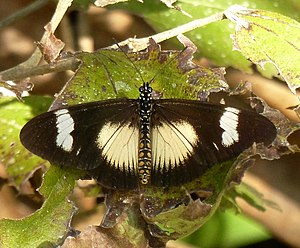Acraea esebria
| Acraea esebria | ||||||||||||
|---|---|---|---|---|---|---|---|---|---|---|---|---|

Acraea esebria |
||||||||||||
| Systematics | ||||||||||||
|
||||||||||||
| Scientific name | ||||||||||||
| Acraea esebria | ||||||||||||
| ( Hewitson , 1861) |
Acraea esebria is occurring in Africa Butterfly ( butterfly ) from the family of Nymphalidae (Nymphalidae).
features
butterfly
The wingspan of the moth is 20 to 40 millimeters. The females are slightly larger than the males. In both sexes, the wings have a black base color. On the top of the forewing, a whitish band stands out from the front edge towards the outer edge , but does not reach it. A flat, bright, semicircular spot begins at the inner edge . Another large, bright spot begins on the front edge of the upper side of the hind wing. In the butterfly's preferred half-open wing position, the two bright spots merge into a large, eye-like figure. The color of the spots varies from whitish to yellowish to pale orange. The dark veins stand out clearly from the creamy white undersides of the wings. There are several small black points in the orange-yellow basal region . The head and thorax are dotted black and white. A row of orange-yellow, circular spots stand out on each side of the dark abdomen .
Caterpillar
Adult caterpillars are olive-green in color and show a light yellow, black-edged ring on each body segment, each with four prickly branched thorns. The head capsule is black.
Similar species
The moths of Acraea aganice and Acraea cabira show a similar wing pattern , but the light spot on the inner edge on the upper side of the forewing is smaller or absent in Acraea aganice and larger in Acraea cabira than in Acraea esebria .
distribution and habitat
Acraea esebria occurs in southeastern Africa, but is absent in Madagascar . The species prefers to colonize sunny grasslands.
Way of life
The moths fly all year round. They are most numerous from April to June. They like to suckle on flowers to take in nectar. The caterpillars feed primarily on the leaves of nettle (Urticaceae) or commelina plants (Commelinaceae).
Individual evidence
- ↑ a b Dino J. Martins & Ateve Collins: Pocket Guide Butterflies of East Africa , Struik Nature, 2016, ISBN 978-1-77584-242-2
- ↑ inaturalist.org flight time and photos
literature
Dino J. Martins & Ateve Collins: Pocket Guide Butterflies of East Africa , Struik Nature, 2016, ISBN 978-1-77584-242-2
Web links
- biodiversityexplorer aganice - Acraea aganice (for comparison)
- biodiversityexplorer cabira - Acraea cabira (for comparison)

